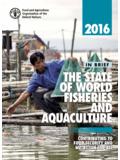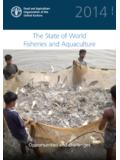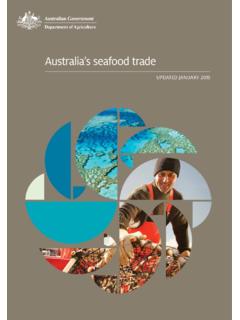Transcription of Livestock and livelihoods in rural Tanzania - World …
1 Livestock and livelihoods in rural Tanzania A descriptive analysis of the 2009 National Panel Survey Katia Covarrubias, Longin Nsiima and Alberto Zezza The authors, listed in alphabetical order, are respectively with the Agricultural Development Economics Division (ESA) of the Food and Agricultural Organization (FAO), the Ministry of Livestock and Fisheries Development of Tanzania , and with the Development Research Group (DECRG) of the World Bank. Corresponding author is Zezza: The authors are grateful to Derek Baker, Gero Carletto, Luc Christiaensen, Ana Paula de la O, Nancy Morgan and Ugo Pica-Ciamarra for comments on earlier drafts. Exchanges and discussions on data issues with Leigh Anderson, Kathleen Beegle, Kristen Himelein, Jon Kastelic, Amparo Palacios-Lopez, and Waly Wane were extremely useful in completing this work.
2 Raka Banerjee has been of tremendous help in putting the final manuscript together. None of these people, or the institutions the authors are affiliated with, bears any responsibility for the content of the paper which rests solely with the authors. July 2012 Joint paper of the World Bank, FAO, AU-IBAR, ILRI and the Tanzania Ministry of Livestock and Fisheries Development with support from the Gates Foundation THE UNITED REPUBLIC OF Tanzania MINISTRY OF Livestock AND FISHERIES DEVELOPMENT 2 TABLE OF CONTENTS EXECUTIVE SUMMARY .. 3 1. BACKGROUND .. 9 2. THE DATA .. 10 3. rural HOUSEHOLD livelihoods .. 11 Basic household characteristics .. 11 Income patterns .. 12 Land holdings: a smallholder sector.
3 14 4. Livestock IN livelihoods .. 18 Participation and income shares .. 18 Herd characteristics .. 19 Access to inputs, credit and extension services .. 23 Commercialization of Livestock products .. 30 Livestock and gender .. 33 Demand for Livestock 40 5. CONCLUSIONS .. 47 REFERENCES .. 51 ANNEX 1. METHODOLOGY IN THE ESTIMATION OF INCOME LEVELS AND RELATED VARIABLES .. 53 Income 53 Income levels .. 53 Participation in income activities .. 53 Income shares .. 54 ANNEX 2. ADDITIONAL DEMAND TABLES .. 55 3 EXECUTIVE SUMMARY This report presents an analysis of rural livelihoods in Tanzania , with particular emphasis on the Livestock sub-sector, smallholder farmers living standards, and issues with access to productive assets.
4 The report attempts to answer basic questions such as: To what extent is keeping Livestock an activity of the relatively better off, and to what extent are poorer households able to engage? How does the role of Livestock vary with different levels of income and well-being? How are Livestock holding size and structure associated with differences in welfare, gender, and geography? How important are input and output markets for small Livestock keepers? What form does this market participation take in practice, and what is its extent? How important are some of the non-income services of Livestock ( , manure, draught power) for crop production? The study is based on data from the Tanzania National Panel Survey (NPS) collected by the National Bureau of Statistics (NBS) from October 2008 to October 2009 as part of the first wave of a nationally representative living standards survey.
5 The NPS was conducted by the NBS with technical assistance and financial support from the World Bank s Living Standards Measurement Study Integrated Surveys on Agriculture (LSMS-ISA) project (funded by the Bill and Melinda Gates Foundation), as well as the Kingdom of Denmark, the United Nations Children s Fund (UNICEF), and the United Nations Population Fund (UNFPA). The extensive focus of the survey on agriculture, atypical of previous living standard surveys in Tanzania , offers a wealth of data on the range of agricultural activities relevant for the country. One limitation of the report, driven by the data, is that it covers only farm household operations.
6 Large scale corporate farms are not included in the NPS survey and hence in this study. A diverse rural economy, with agriculture as the backbone The near totality of rural households in Tanzania has some level of involvement in agricultural activities. Three fifths of rural households earn income from Livestock husbandry, while 97 percent cultivate crops and approximately one fifth are employed as agricultural wage laborers. Agricultural activities combined (crop, Livestock , and agricultural wage labor) amount to 70 percent of total income for rural households (53 percent from crop production, 13 percent from Livestock , and four percent from agricultural wages).
7 Self-employed farming is clearly the mainstay of rural livelihoods , with 53 percent of households deriving 75 percent or more of their income from self-employed farming. Participation in non-agricultural self-employment is similar to that of other developing countries (Davis et al., 2010), with 34 percent of rural households engaged in these activities. The non-agricultural sector provides a non-negligible 30 percent of total income, seven percent of 4 which originates from non-agricultural wages, 13 percent from non-agricultural self-employment, and 10 percent from transfers (mostly private transfers from relatives). Agriculture: A sector of small-holder farmers The NPS data yield the picture of a heterogeneous agricultural sector dominated by smallholder farmers.
8 Average land ownership and operations are both at about hectares, and less than five percent of rural households own or operate more than five hectares of land. Even in the top land quintile, average land operations are smaller than 4 hectares. Most rural households appear to be engaged in subsistence agriculture. On average, 67 percent of agricultural production is consumed by the household, 30 percent is marketed, and the remainder is used as input or allocated to other uses. Larger farmers tend to market a greater share of their agricultural output when compared to smallholders. Farming households in the top land operated quintile still consume a major part of their output at home, but they sell close to 40 percent of it on the market.
9 The statistics on agricultural input use and purchases that emerge from the NPS point to a farming sector characterized by an extremely limited use of modern inputs. Only 30 percent of households report using any fertilizers, and 15 percent report the purchase of pesticides. Meanwhile, 58 percent of rural households purchased seeds for agriculture, but just 14 percent purchased improved seed varieties and only 12 percent bought certified improved varieties. Seed use is therefore largely made up of traditional varieties. As expected, the agricultural practices of larger farmers are somewhat more reliant on the use of seeds, fertilizers, and pesticides/herbicides. Most rural households have some Livestock About three out of five rural households report some income from Livestock activities, earning an average 22 percent of total household income from Livestock rearing.
10 Both the share of rural households participating and the income shares from participation in Livestock activities increase with welfare, as measured by expenditure quintiles. For the bottom quintile, 49 percent of households participate and Livestock contributes to 18 percent of their total household income. At the top 20 percent of the expenditure distribution, the corresponding percentages are 69 percent for participation in Livestock activities, and 24 percent for the share of income earned from them. The NPS data provide an opportunity to look closely the relationship between overall household welfare and Livestock ownership in Tanzania . This can yield important indicators on i) the presence and extent of inequality and concentration within the Livestock sector, ii) whether there are structural impediments in the access of the poor to Livestock ownership, and iii) the extent to which investments in different types of Livestock can be a vehicle for poverty reduction.

















